Evaluation of Inclusive Practices, Equality Act in Education: A Report
VerifiedAdded on 2023/01/11
|9
|2013
|92
Report
AI Summary
This report examines the critical concepts of inclusion and equality within the context of education, focusing on the practical implications of the Equality Act 2010 and the experiences of disabled youth. The report includes a case study on educational transitions for students with disabilities, drawing on research from the Longitudinal Study of Young People in England (LSYPE). It explores the impact of both primary and secondary effects on educational outcomes, considering factors such as school performance, bullying, and suppressed educational expectations. The report also outlines best practices for fostering diversity, equality, and inclusion in education, including equal access to opportunities, fair treatment, and the importance of addressing stigma and labeling. Recommendations are provided for improving policies and practices to better support students with disabilities, including raising awareness of government policies, strict enforcement against bullying, and the avoidance of negative stereotypes. The report concludes that positive thinking and appropriate guidance are essential for creating an inclusive and equitable educational environment.
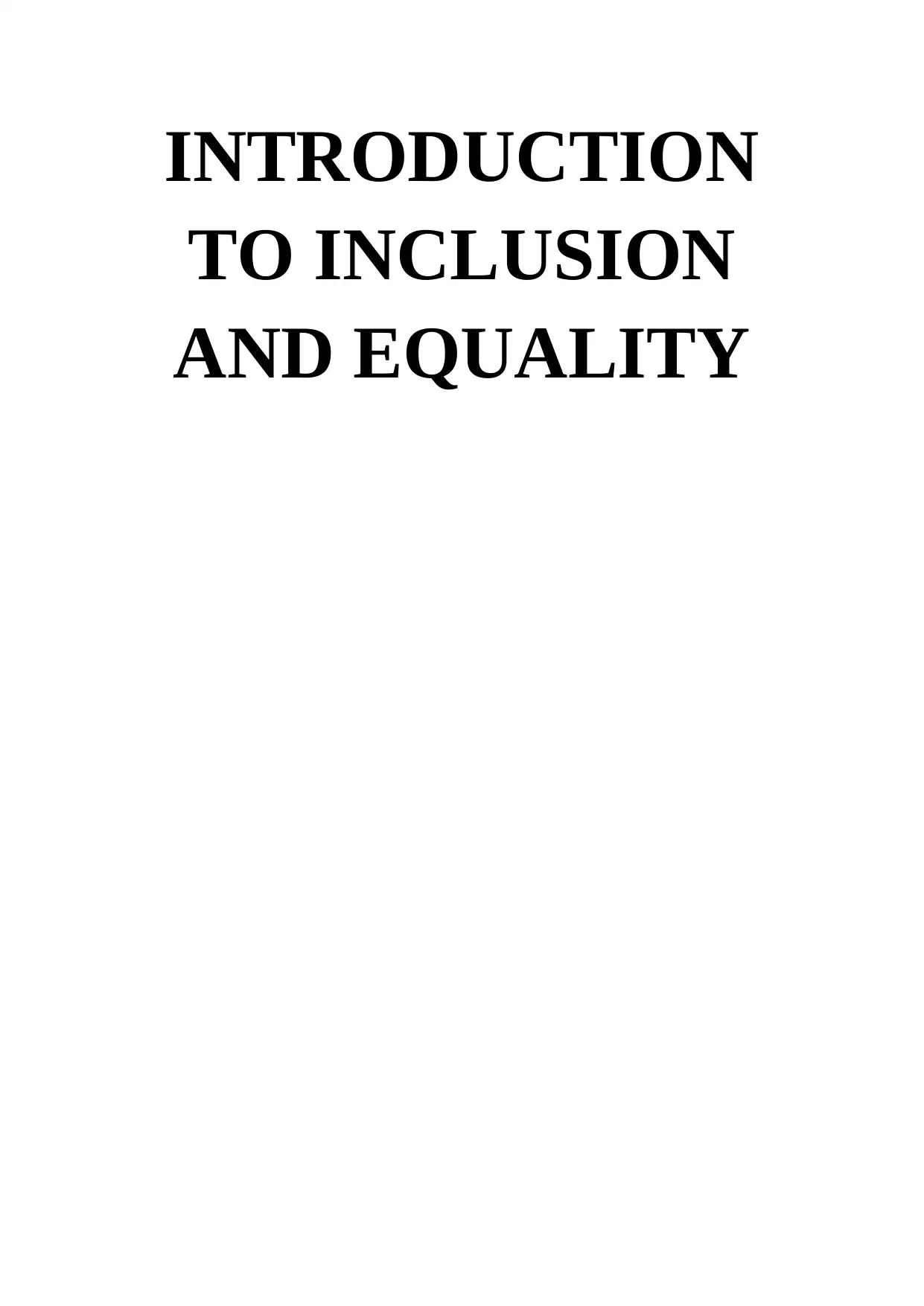
INTRODUCTION
TO INCLUSION
AND EQUALITY
TO INCLUSION
AND EQUALITY
Paraphrase This Document
Need a fresh take? Get an instant paraphrase of this document with our AI Paraphraser
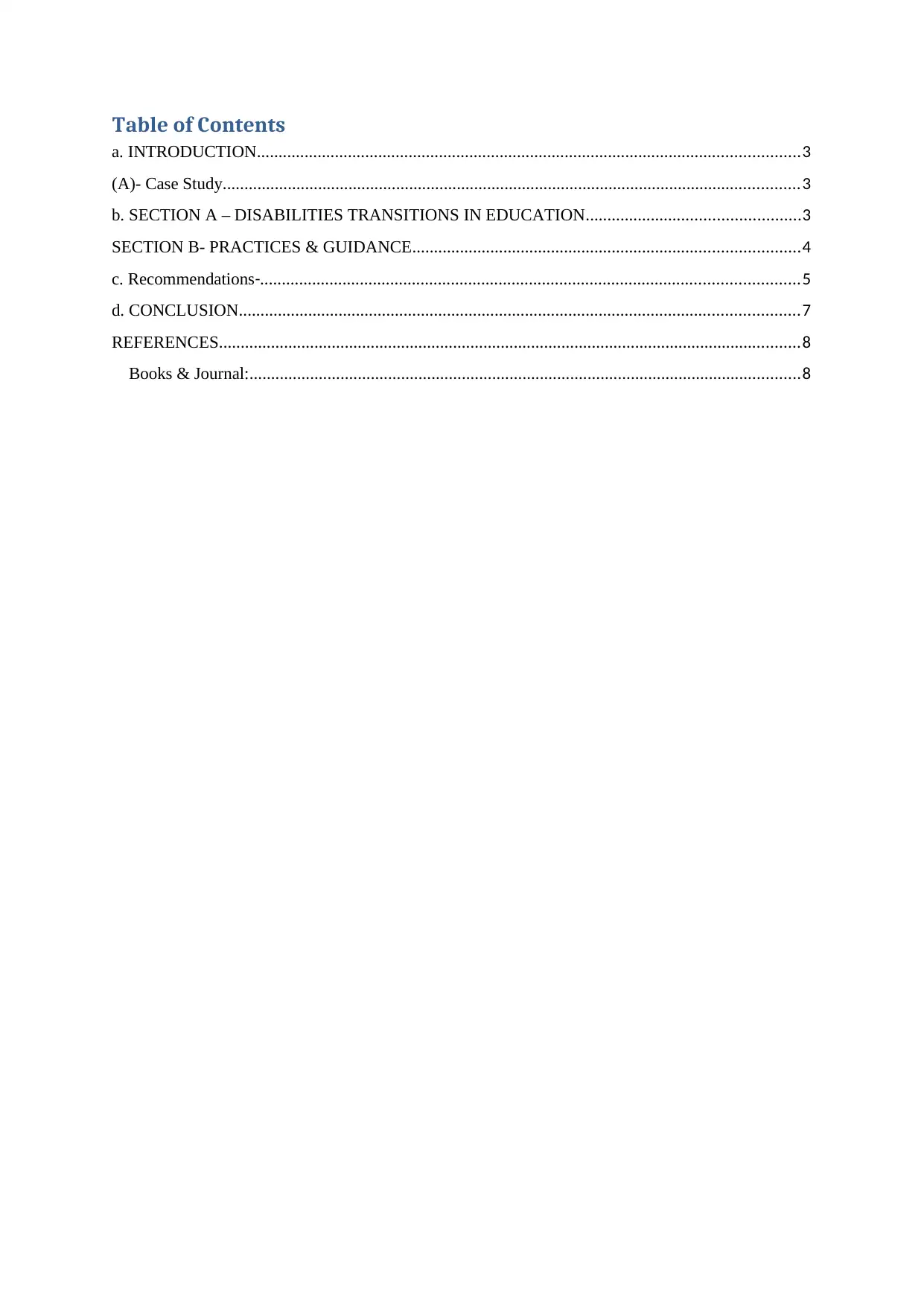
Table of Contents
a. INTRODUCTION.............................................................................................................................3
(A)- Case Study.....................................................................................................................................3
b. SECTION A – DISABILITIES TRANSITIONS IN EDUCATION.................................................3
SECTION B- PRACTICES & GUIDANCE.........................................................................................4
c. Recommendations-............................................................................................................................5
d. CONCLUSION.................................................................................................................................7
REFERENCES......................................................................................................................................8
Books & Journal:...............................................................................................................................8
a. INTRODUCTION.............................................................................................................................3
(A)- Case Study.....................................................................................................................................3
b. SECTION A – DISABILITIES TRANSITIONS IN EDUCATION.................................................3
SECTION B- PRACTICES & GUIDANCE.........................................................................................4
c. Recommendations-............................................................................................................................5
d. CONCLUSION.................................................................................................................................7
REFERENCES......................................................................................................................................8
Books & Journal:...............................................................................................................................8
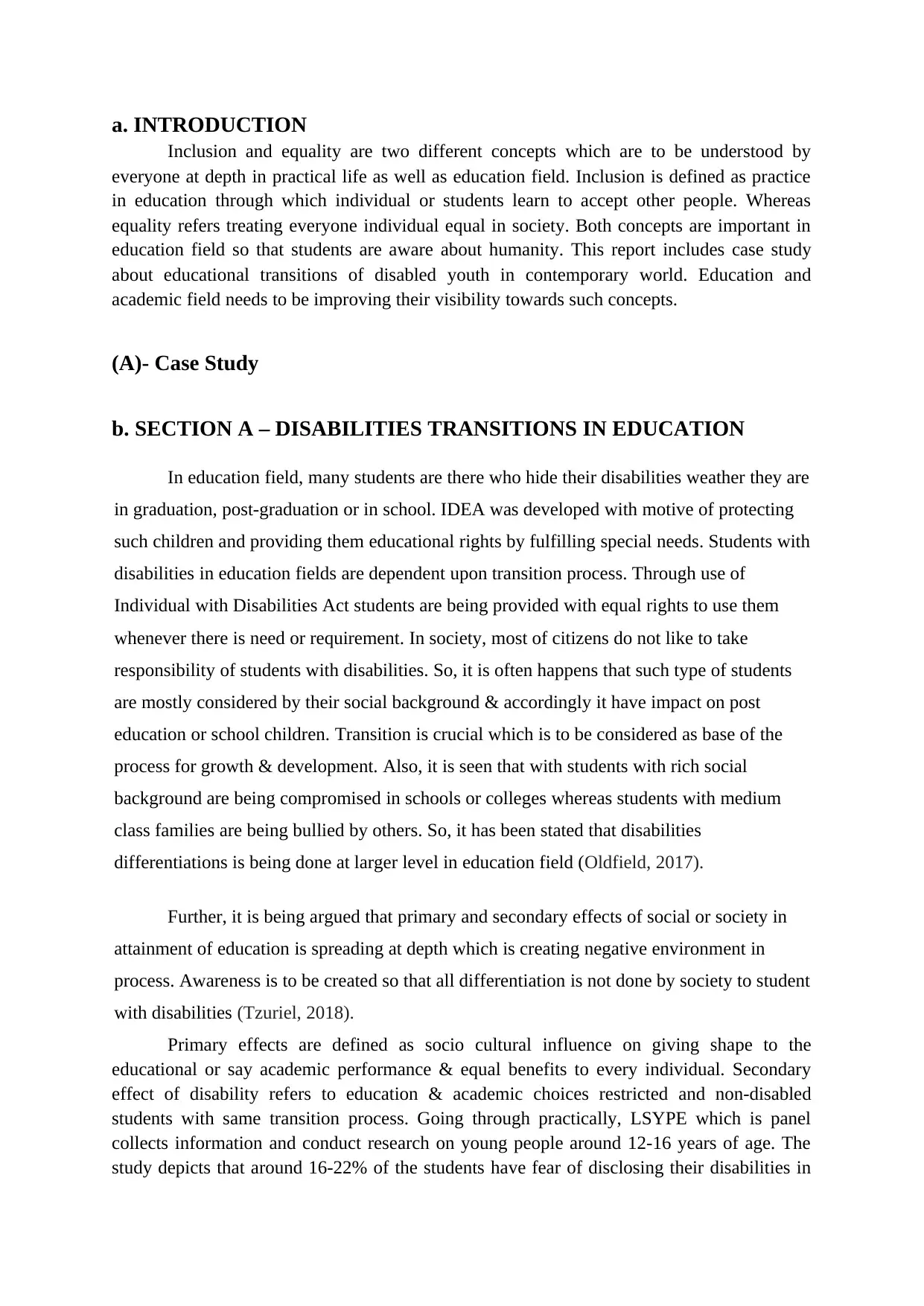
a. INTRODUCTION
Inclusion and equality are two different concepts which are to be understood by
everyone at depth in practical life as well as education field. Inclusion is defined as practice
in education through which individual or students learn to accept other people. Whereas
equality refers treating everyone individual equal in society. Both concepts are important in
education field so that students are aware about humanity. This report includes case study
about educational transitions of disabled youth in contemporary world. Education and
academic field needs to be improving their visibility towards such concepts.
(A)- Case Study
b. SECTION A – DISABILITIES TRANSITIONS IN EDUCATION
In education field, many students are there who hide their disabilities weather they are
in graduation, post-graduation or in school. IDEA was developed with motive of protecting
such children and providing them educational rights by fulfilling special needs. Students with
disabilities in education fields are dependent upon transition process. Through use of
Individual with Disabilities Act students are being provided with equal rights to use them
whenever there is need or requirement. In society, most of citizens do not like to take
responsibility of students with disabilities. So, it is often happens that such type of students
are mostly considered by their social background & accordingly it have impact on post
education or school children. Transition is crucial which is to be considered as base of the
process for growth & development. Also, it is seen that with students with rich social
background are being compromised in schools or colleges whereas students with medium
class families are being bullied by others. So, it has been stated that disabilities
differentiations is being done at larger level in education field (Oldfield, 2017).
Further, it is being argued that primary and secondary effects of social or society in
attainment of education is spreading at depth which is creating negative environment in
process. Awareness is to be created so that all differentiation is not done by society to student
with disabilities (Tzuriel, 2018).
Primary effects are defined as socio cultural influence on giving shape to the
educational or say academic performance & equal benefits to every individual. Secondary
effect of disability refers to education & academic choices restricted and non-disabled
students with same transition process. Going through practically, LSYPE which is panel
collects information and conduct research on young people around 12-16 years of age. The
study depicts that around 16-22% of the students have fear of disclosing their disabilities in
Inclusion and equality are two different concepts which are to be understood by
everyone at depth in practical life as well as education field. Inclusion is defined as practice
in education through which individual or students learn to accept other people. Whereas
equality refers treating everyone individual equal in society. Both concepts are important in
education field so that students are aware about humanity. This report includes case study
about educational transitions of disabled youth in contemporary world. Education and
academic field needs to be improving their visibility towards such concepts.
(A)- Case Study
b. SECTION A – DISABILITIES TRANSITIONS IN EDUCATION
In education field, many students are there who hide their disabilities weather they are
in graduation, post-graduation or in school. IDEA was developed with motive of protecting
such children and providing them educational rights by fulfilling special needs. Students with
disabilities in education fields are dependent upon transition process. Through use of
Individual with Disabilities Act students are being provided with equal rights to use them
whenever there is need or requirement. In society, most of citizens do not like to take
responsibility of students with disabilities. So, it is often happens that such type of students
are mostly considered by their social background & accordingly it have impact on post
education or school children. Transition is crucial which is to be considered as base of the
process for growth & development. Also, it is seen that with students with rich social
background are being compromised in schools or colleges whereas students with medium
class families are being bullied by others. So, it has been stated that disabilities
differentiations is being done at larger level in education field (Oldfield, 2017).
Further, it is being argued that primary and secondary effects of social or society in
attainment of education is spreading at depth which is creating negative environment in
process. Awareness is to be created so that all differentiation is not done by society to student
with disabilities (Tzuriel, 2018).
Primary effects are defined as socio cultural influence on giving shape to the
educational or say academic performance & equal benefits to every individual. Secondary
effect of disability refers to education & academic choices restricted and non-disabled
students with same transition process. Going through practically, LSYPE which is panel
collects information and conduct research on young people around 12-16 years of age. The
study depicts that around 16-22% of the students have fear of disclosing their disabilities in
⊘ This is a preview!⊘
Do you want full access?
Subscribe today to unlock all pages.

Trusted by 1+ million students worldwide
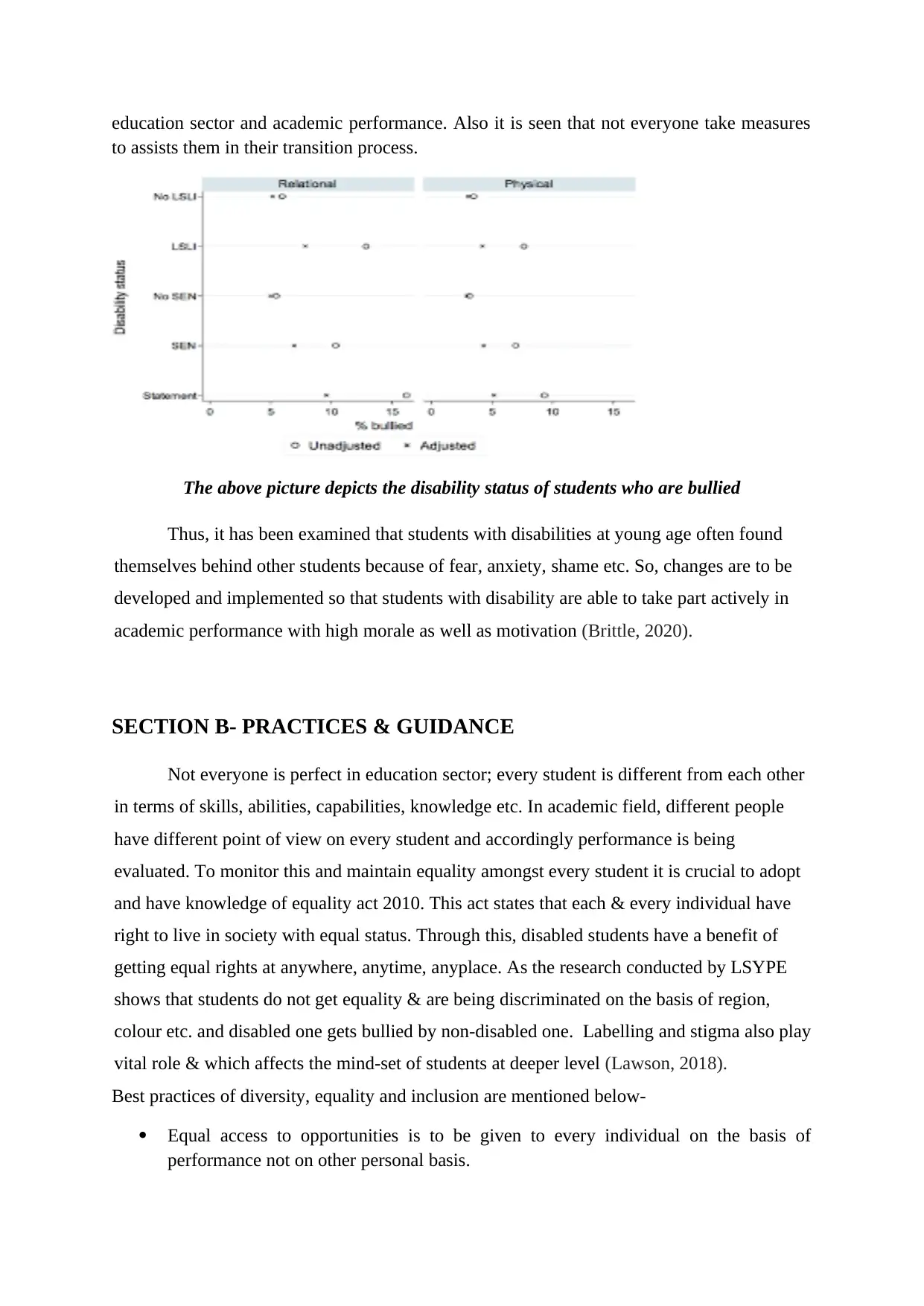
education sector and academic performance. Also it is seen that not everyone take measures
to assists them in their transition process.
The above picture depicts the disability status of students who are bullied
Thus, it has been examined that students with disabilities at young age often found
themselves behind other students because of fear, anxiety, shame etc. So, changes are to be
developed and implemented so that students with disability are able to take part actively in
academic performance with high morale as well as motivation (Brittle, 2020).
SECTION B- PRACTICES & GUIDANCE
Not everyone is perfect in education sector; every student is different from each other
in terms of skills, abilities, capabilities, knowledge etc. In academic field, different people
have different point of view on every student and accordingly performance is being
evaluated. To monitor this and maintain equality amongst every student it is crucial to adopt
and have knowledge of equality act 2010. This act states that each & every individual have
right to live in society with equal status. Through this, disabled students have a benefit of
getting equal rights at anywhere, anytime, anyplace. As the research conducted by LSYPE
shows that students do not get equality & are being discriminated on the basis of region,
colour etc. and disabled one gets bullied by non-disabled one. Labelling and stigma also play
vital role & which affects the mind-set of students at deeper level (Lawson, 2018).
Best practices of diversity, equality and inclusion are mentioned below-
Equal access to opportunities is to be given to every individual on the basis of
performance not on other personal basis.
to assists them in their transition process.
The above picture depicts the disability status of students who are bullied
Thus, it has been examined that students with disabilities at young age often found
themselves behind other students because of fear, anxiety, shame etc. So, changes are to be
developed and implemented so that students with disability are able to take part actively in
academic performance with high morale as well as motivation (Brittle, 2020).
SECTION B- PRACTICES & GUIDANCE
Not everyone is perfect in education sector; every student is different from each other
in terms of skills, abilities, capabilities, knowledge etc. In academic field, different people
have different point of view on every student and accordingly performance is being
evaluated. To monitor this and maintain equality amongst every student it is crucial to adopt
and have knowledge of equality act 2010. This act states that each & every individual have
right to live in society with equal status. Through this, disabled students have a benefit of
getting equal rights at anywhere, anytime, anyplace. As the research conducted by LSYPE
shows that students do not get equality & are being discriminated on the basis of region,
colour etc. and disabled one gets bullied by non-disabled one. Labelling and stigma also play
vital role & which affects the mind-set of students at deeper level (Lawson, 2018).
Best practices of diversity, equality and inclusion are mentioned below-
Equal access to opportunities is to be given to every individual on the basis of
performance not on other personal basis.
Paraphrase This Document
Need a fresh take? Get an instant paraphrase of this document with our AI Paraphraser
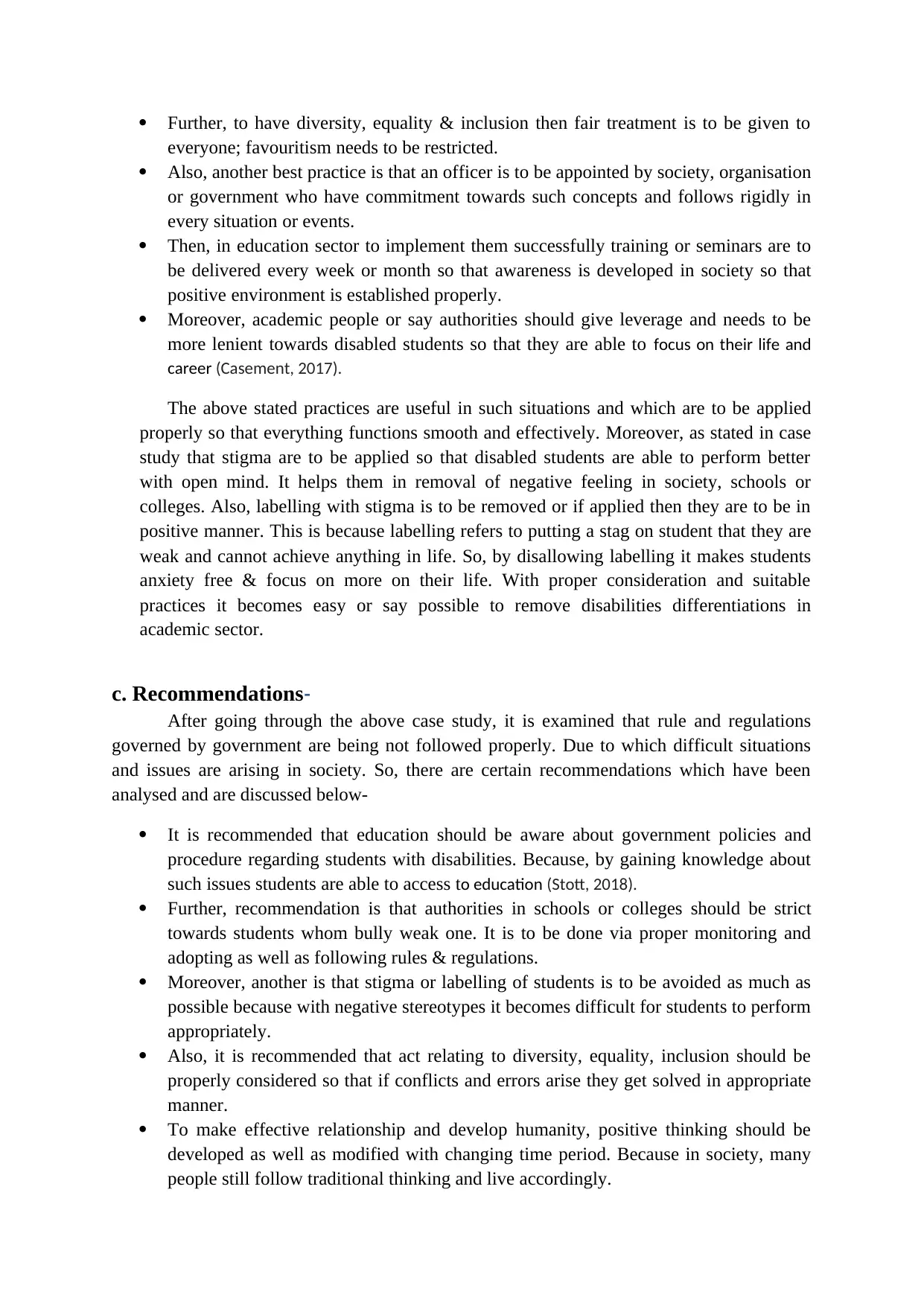
Further, to have diversity, equality & inclusion then fair treatment is to be given to
everyone; favouritism needs to be restricted.
Also, another best practice is that an officer is to be appointed by society, organisation
or government who have commitment towards such concepts and follows rigidly in
every situation or events.
Then, in education sector to implement them successfully training or seminars are to
be delivered every week or month so that awareness is developed in society so that
positive environment is established properly.
Moreover, academic people or say authorities should give leverage and needs to be
more lenient towards disabled students so that they are able to focus on their life and
career (Casement, 2017).
The above stated practices are useful in such situations and which are to be applied
properly so that everything functions smooth and effectively. Moreover, as stated in case
study that stigma are to be applied so that disabled students are able to perform better
with open mind. It helps them in removal of negative feeling in society, schools or
colleges. Also, labelling with stigma is to be removed or if applied then they are to be in
positive manner. This is because labelling refers to putting a stag on student that they are
weak and cannot achieve anything in life. So, by disallowing labelling it makes students
anxiety free & focus on more on their life. With proper consideration and suitable
practices it becomes easy or say possible to remove disabilities differentiations in
academic sector.
c. Recommendations-
After going through the above case study, it is examined that rule and regulations
governed by government are being not followed properly. Due to which difficult situations
and issues are arising in society. So, there are certain recommendations which have been
analysed and are discussed below-
It is recommended that education should be aware about government policies and
procedure regarding students with disabilities. Because, by gaining knowledge about
such issues students are able to access to education (Stott, 2018).
Further, recommendation is that authorities in schools or colleges should be strict
towards students whom bully weak one. It is to be done via proper monitoring and
adopting as well as following rules & regulations.
Moreover, another is that stigma or labelling of students is to be avoided as much as
possible because with negative stereotypes it becomes difficult for students to perform
appropriately.
Also, it is recommended that act relating to diversity, equality, inclusion should be
properly considered so that if conflicts and errors arise they get solved in appropriate
manner.
To make effective relationship and develop humanity, positive thinking should be
developed as well as modified with changing time period. Because in society, many
people still follow traditional thinking and live accordingly.
everyone; favouritism needs to be restricted.
Also, another best practice is that an officer is to be appointed by society, organisation
or government who have commitment towards such concepts and follows rigidly in
every situation or events.
Then, in education sector to implement them successfully training or seminars are to
be delivered every week or month so that awareness is developed in society so that
positive environment is established properly.
Moreover, academic people or say authorities should give leverage and needs to be
more lenient towards disabled students so that they are able to focus on their life and
career (Casement, 2017).
The above stated practices are useful in such situations and which are to be applied
properly so that everything functions smooth and effectively. Moreover, as stated in case
study that stigma are to be applied so that disabled students are able to perform better
with open mind. It helps them in removal of negative feeling in society, schools or
colleges. Also, labelling with stigma is to be removed or if applied then they are to be in
positive manner. This is because labelling refers to putting a stag on student that they are
weak and cannot achieve anything in life. So, by disallowing labelling it makes students
anxiety free & focus on more on their life. With proper consideration and suitable
practices it becomes easy or say possible to remove disabilities differentiations in
academic sector.
c. Recommendations-
After going through the above case study, it is examined that rule and regulations
governed by government are being not followed properly. Due to which difficult situations
and issues are arising in society. So, there are certain recommendations which have been
analysed and are discussed below-
It is recommended that education should be aware about government policies and
procedure regarding students with disabilities. Because, by gaining knowledge about
such issues students are able to access to education (Stott, 2018).
Further, recommendation is that authorities in schools or colleges should be strict
towards students whom bully weak one. It is to be done via proper monitoring and
adopting as well as following rules & regulations.
Moreover, another is that stigma or labelling of students is to be avoided as much as
possible because with negative stereotypes it becomes difficult for students to perform
appropriately.
Also, it is recommended that act relating to diversity, equality, inclusion should be
properly considered so that if conflicts and errors arise they get solved in appropriate
manner.
To make effective relationship and develop humanity, positive thinking should be
developed as well as modified with changing time period. Because in society, many
people still follow traditional thinking and live accordingly.
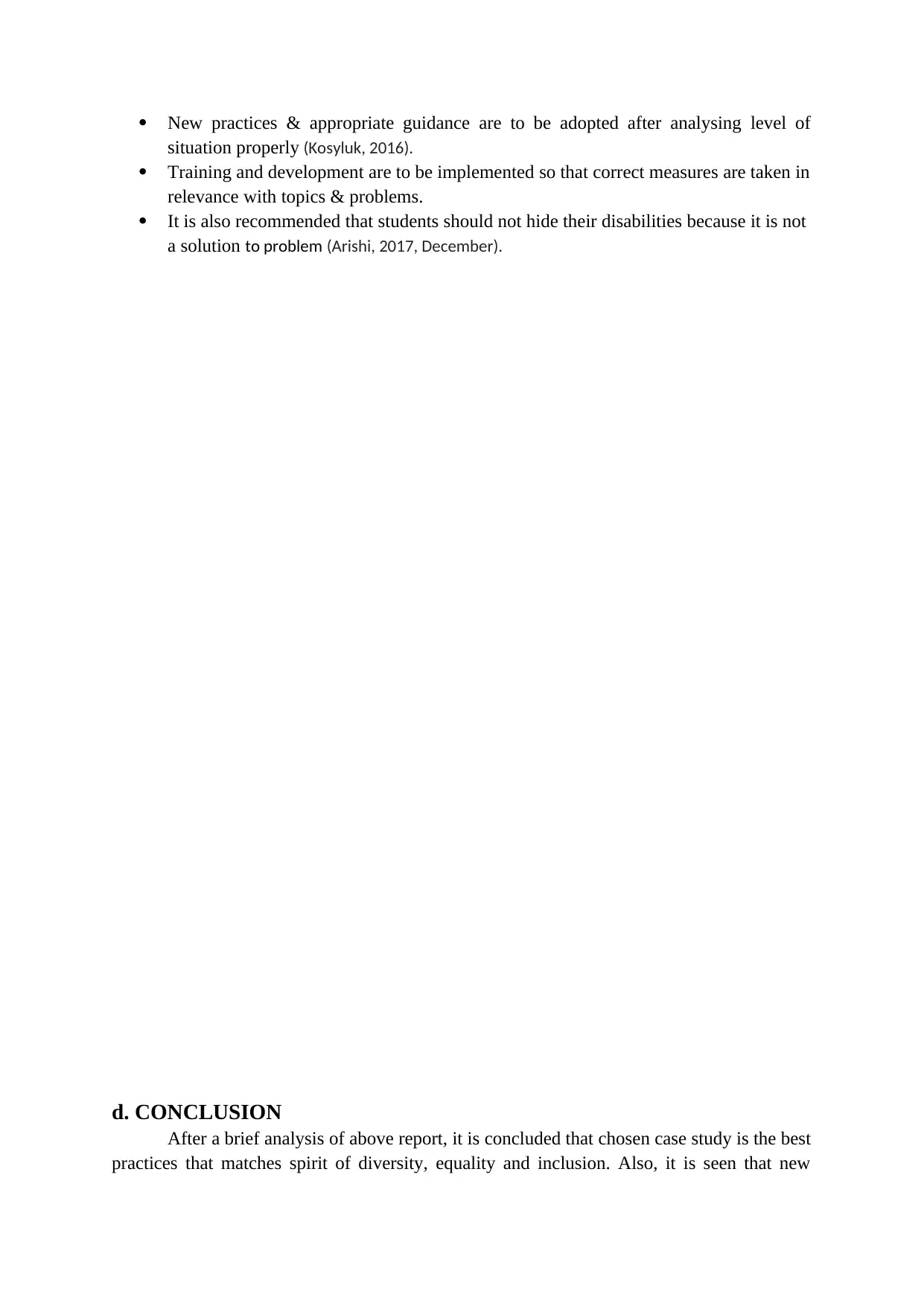
New practices & appropriate guidance are to be adopted after analysing level of
situation properly (Kosyluk, 2016).
Training and development are to be implemented so that correct measures are taken in
relevance with topics & problems.
It is also recommended that students should not hide their disabilities because it is not
a solution to problem (Arishi, 2017, December).
d. CONCLUSION
After a brief analysis of above report, it is concluded that chosen case study is the best
practices that matches spirit of diversity, equality and inclusion. Also, it is seen that new
situation properly (Kosyluk, 2016).
Training and development are to be implemented so that correct measures are taken in
relevance with topics & problems.
It is also recommended that students should not hide their disabilities because it is not
a solution to problem (Arishi, 2017, December).
d. CONCLUSION
After a brief analysis of above report, it is concluded that chosen case study is the best
practices that matches spirit of diversity, equality and inclusion. Also, it is seen that new
⊘ This is a preview!⊘
Do you want full access?
Subscribe today to unlock all pages.

Trusted by 1+ million students worldwide
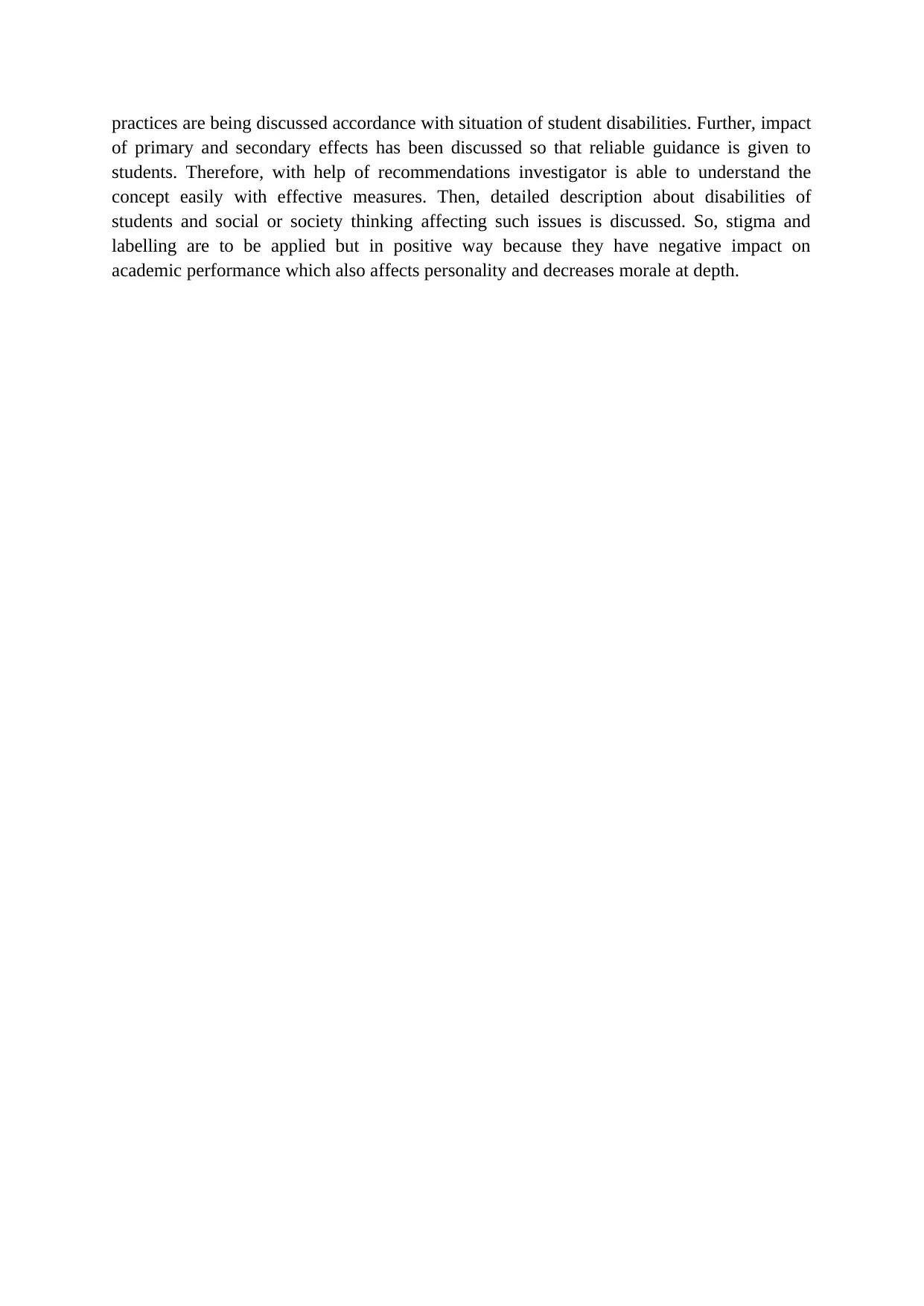
practices are being discussed accordance with situation of student disabilities. Further, impact
of primary and secondary effects has been discussed so that reliable guidance is given to
students. Therefore, with help of recommendations investigator is able to understand the
concept easily with effective measures. Then, detailed description about disabilities of
students and social or society thinking affecting such issues is discussed. So, stigma and
labelling are to be applied but in positive way because they have negative impact on
academic performance which also affects personality and decreases morale at depth.
of primary and secondary effects has been discussed so that reliable guidance is given to
students. Therefore, with help of recommendations investigator is able to understand the
concept easily with effective measures. Then, detailed description about disabilities of
students and social or society thinking affecting such issues is discussed. So, stigma and
labelling are to be applied but in positive way because they have negative impact on
academic performance which also affects personality and decreases morale at depth.
Paraphrase This Document
Need a fresh take? Get an instant paraphrase of this document with our AI Paraphraser
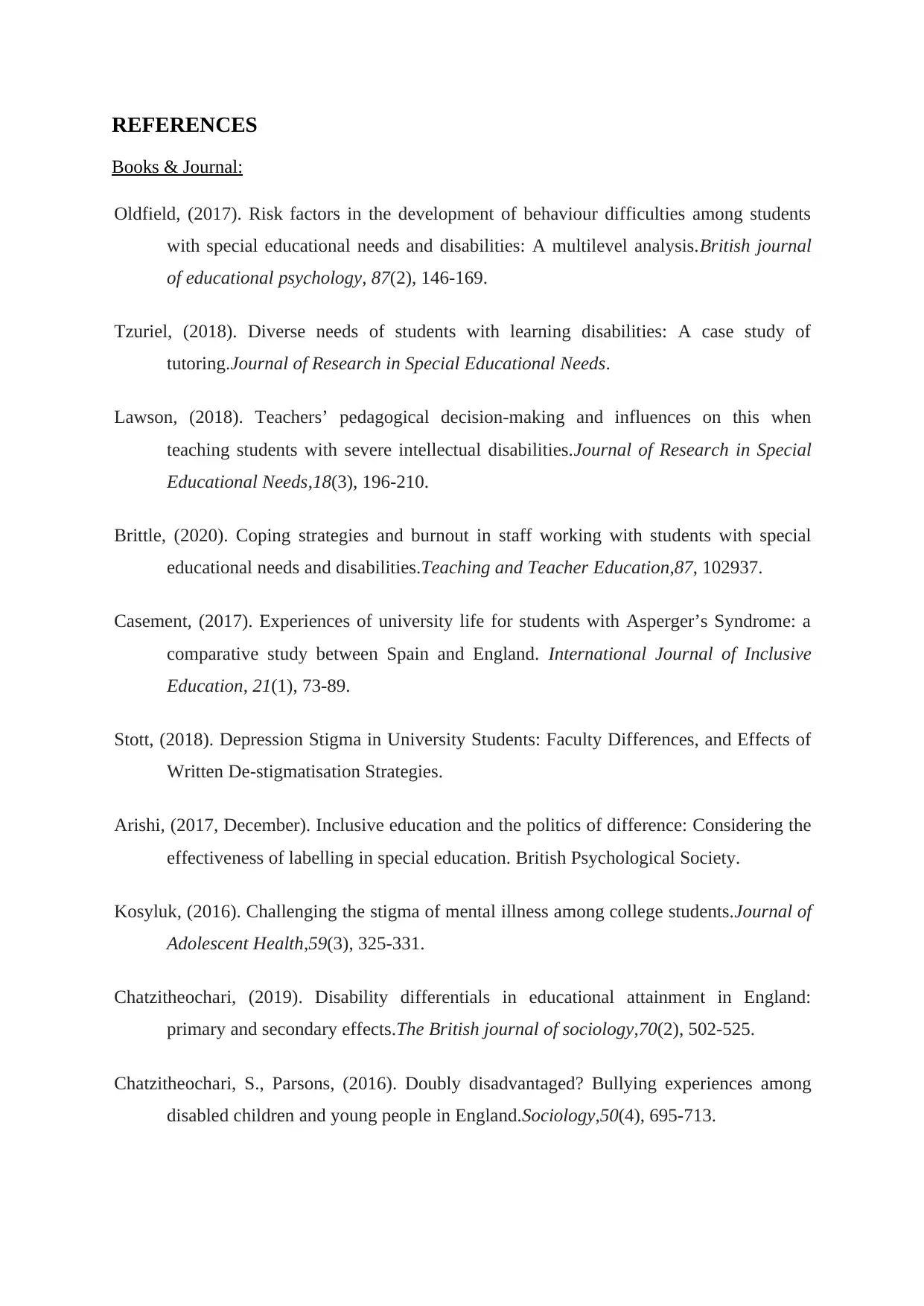
REFERENCES
Books & Journal:
Oldfield, (2017). Risk factors in the development of behaviour difficulties among students
with special educational needs and disabilities: A multilevel analysis.British journal
of educational psychology, 87(2), 146-169.
Tzuriel, (2018). Diverse needs of students with learning disabilities: A case study of
tutoring.Journal of Research in Special Educational Needs.
Lawson, (2018). Teachers’ pedagogical decision‐making and influences on this when
teaching students with severe intellectual disabilities.Journal of Research in Special
Educational Needs,18(3), 196-210.
Brittle, (2020). Coping strategies and burnout in staff working with students with special
educational needs and disabilities.Teaching and Teacher Education,87, 102937.
Casement, (2017). Experiences of university life for students with Asperger’s Syndrome: a
comparative study between Spain and England. International Journal of Inclusive
Education, 21(1), 73-89.
Stott, (2018). Depression Stigma in University Students: Faculty Differences, and Effects of
Written De-stigmatisation Strategies.
Arishi, (2017, December). Inclusive education and the politics of difference: Considering the
effectiveness of labelling in special education. British Psychological Society.
Kosyluk, (2016). Challenging the stigma of mental illness among college students.Journal of
Adolescent Health,59(3), 325-331.
Chatzitheochari, (2019). Disability differentials in educational attainment in England:
primary and secondary effects.The British journal of sociology,70(2), 502-525.
Chatzitheochari, S., Parsons, (2016). Doubly disadvantaged? Bullying experiences among
disabled children and young people in England.Sociology,50(4), 695-713.
Books & Journal:
Oldfield, (2017). Risk factors in the development of behaviour difficulties among students
with special educational needs and disabilities: A multilevel analysis.British journal
of educational psychology, 87(2), 146-169.
Tzuriel, (2018). Diverse needs of students with learning disabilities: A case study of
tutoring.Journal of Research in Special Educational Needs.
Lawson, (2018). Teachers’ pedagogical decision‐making and influences on this when
teaching students with severe intellectual disabilities.Journal of Research in Special
Educational Needs,18(3), 196-210.
Brittle, (2020). Coping strategies and burnout in staff working with students with special
educational needs and disabilities.Teaching and Teacher Education,87, 102937.
Casement, (2017). Experiences of university life for students with Asperger’s Syndrome: a
comparative study between Spain and England. International Journal of Inclusive
Education, 21(1), 73-89.
Stott, (2018). Depression Stigma in University Students: Faculty Differences, and Effects of
Written De-stigmatisation Strategies.
Arishi, (2017, December). Inclusive education and the politics of difference: Considering the
effectiveness of labelling in special education. British Psychological Society.
Kosyluk, (2016). Challenging the stigma of mental illness among college students.Journal of
Adolescent Health,59(3), 325-331.
Chatzitheochari, (2019). Disability differentials in educational attainment in England:
primary and secondary effects.The British journal of sociology,70(2), 502-525.
Chatzitheochari, S., Parsons, (2016). Doubly disadvantaged? Bullying experiences among
disabled children and young people in England.Sociology,50(4), 695-713.
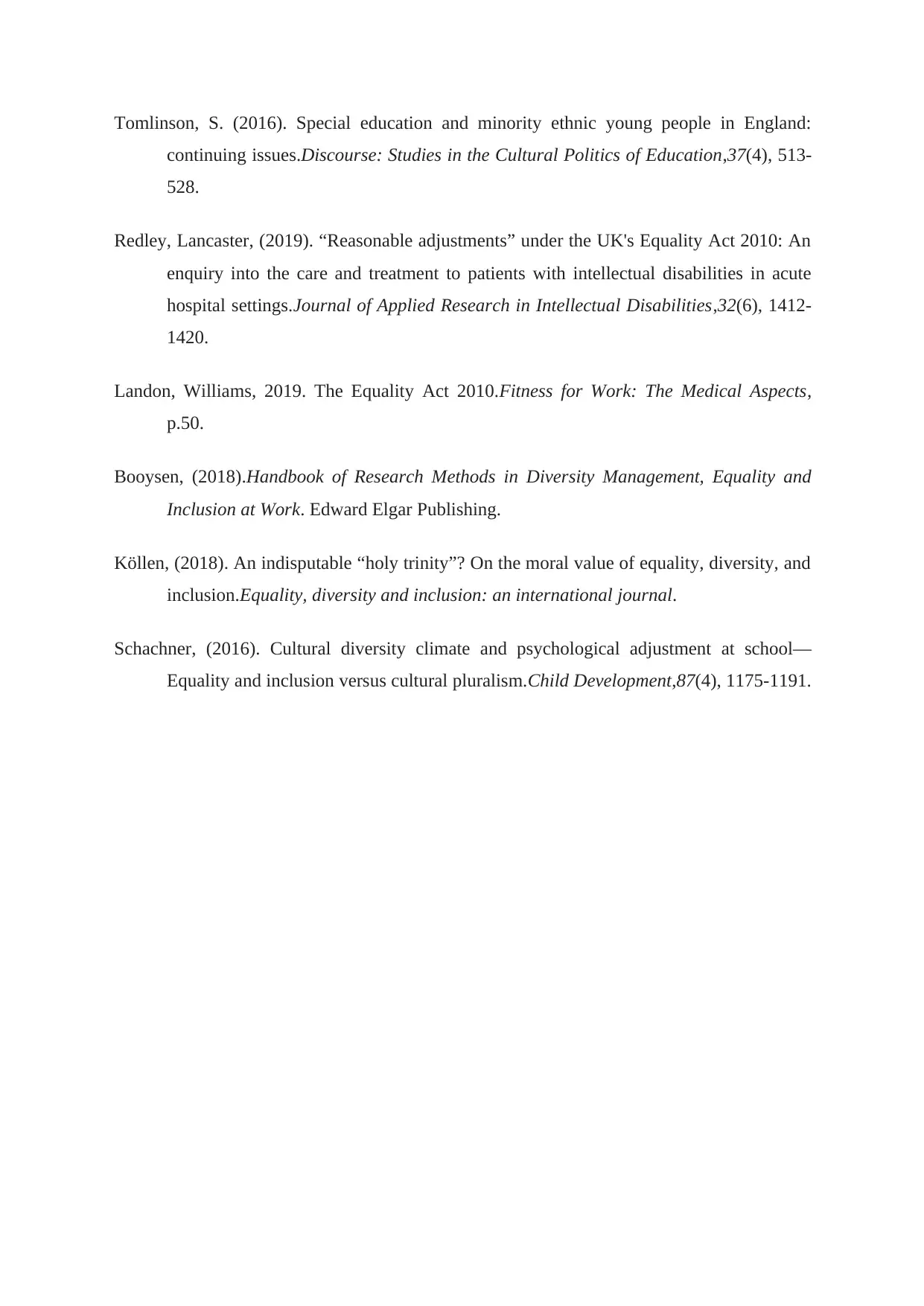
Tomlinson, S. (2016). Special education and minority ethnic young people in England:
continuing issues.Discourse: Studies in the Cultural Politics of Education,37(4), 513-
528.
Redley, Lancaster, (2019). “Reasonable adjustments” under the UK's Equality Act 2010: An
enquiry into the care and treatment to patients with intellectual disabilities in acute
hospital settings.Journal of Applied Research in Intellectual Disabilities,32(6), 1412-
1420.
Landon, Williams, 2019. The Equality Act 2010.Fitness for Work: The Medical Aspects,
p.50.
Booysen, (2018).Handbook of Research Methods in Diversity Management, Equality and
Inclusion at Work. Edward Elgar Publishing.
Köllen, (2018). An indisputable “holy trinity”? On the moral value of equality, diversity, and
inclusion.Equality, diversity and inclusion: an international journal.
Schachner, (2016). Cultural diversity climate and psychological adjustment at school—
Equality and inclusion versus cultural pluralism.Child Development,87(4), 1175-1191.
continuing issues.Discourse: Studies in the Cultural Politics of Education,37(4), 513-
528.
Redley, Lancaster, (2019). “Reasonable adjustments” under the UK's Equality Act 2010: An
enquiry into the care and treatment to patients with intellectual disabilities in acute
hospital settings.Journal of Applied Research in Intellectual Disabilities,32(6), 1412-
1420.
Landon, Williams, 2019. The Equality Act 2010.Fitness for Work: The Medical Aspects,
p.50.
Booysen, (2018).Handbook of Research Methods in Diversity Management, Equality and
Inclusion at Work. Edward Elgar Publishing.
Köllen, (2018). An indisputable “holy trinity”? On the moral value of equality, diversity, and
inclusion.Equality, diversity and inclusion: an international journal.
Schachner, (2016). Cultural diversity climate and psychological adjustment at school—
Equality and inclusion versus cultural pluralism.Child Development,87(4), 1175-1191.
⊘ This is a preview!⊘
Do you want full access?
Subscribe today to unlock all pages.

Trusted by 1+ million students worldwide
1 out of 9
Related Documents
Your All-in-One AI-Powered Toolkit for Academic Success.
+13062052269
info@desklib.com
Available 24*7 on WhatsApp / Email
![[object Object]](/_next/static/media/star-bottom.7253800d.svg)
Unlock your academic potential
Copyright © 2020–2025 A2Z Services. All Rights Reserved. Developed and managed by ZUCOL.



